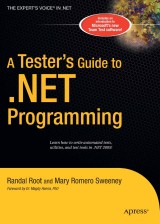Details

A Tester's Guide to .NET Programming
|
48,14 € |
|
| Verlag: | Apress |
| Format: | |
| Veröffentl.: | 21.11.2006 |
| ISBN/EAN: | 9781430201168 |
| Sprache: | englisch |
| Anzahl Seiten: | 632 |
Dieses eBook enthält ein Wasserzeichen.
Beschreibungen
<p><i>A Tester's Guide to .NET Programming</i> focuses solely on applied programming techniques for testers. You will learn how to write simple automated tests, enabling you to test tools and utilities. You will also learn about the important concepts driving modern programming today, like multitier applications and object-oriented programming. More businesses are adopting .NET technologies, and this book will equip you to assess software robustness and performance.</p>
<p>Whether you're an experienced programmer who's unfamiliar with testing concepts, or you're an experienced tester versed in VB .NET and C#, the included real-world tips and example code will help you start your projects. Also included are review questions and hands-on exercises to help you retain knowledge. Additionally, the book features examples and quick language tutorials for both C# and VB .NET.</p>
<p>Whether you're an experienced programmer who's unfamiliar with testing concepts, or you're an experienced tester versed in VB .NET and C#, the included real-world tips and example code will help you start your projects. Also included are review questions and hands-on exercises to help you retain knowledge. Additionally, the book features examples and quick language tutorials for both C# and VB .NET.</p>
Understanding .Net Testing choices.- Outlines the 3 types of .Net Apps(Console, Web(ASP.Net),and Windows) and how they are used for testing.- Choosing a .Net language (Point them to the Tutorials in the back if they need them).- Overview of Testing Terms (Whitebox, BlackBox, Regression, etc.).- Discuss 'When to Automate' Topic.- Lab: Create 3 simple Apps(Console, Web, and Windows).- Storing Test Data (a simple overview).- Documenting your Tests.- Text Files.- Lab: Create a Simple Console App that writes to a text file.- The Registry.- Lab: Create a Simple Windows App that writes to the Registry.- Databases.- Lab: Create a Simple Web App that writes to a Access database.- Overview of the .Net Error handling.- Syntax, Run-time, and Logic errors.- How Try-Catch blocks work.- Using Debug and trace to get debugging information.- The Debugging windows.- Breakpoints.- The Exception Class.- Throwing Exceptions.- Lab: Using the VS.Net debugging tools.- Creating Test Utilities in a Windows Application.- Building a simple test application using procedures.- Describing the purpose of scope within procedures.- Logging an Automated testing project.- The SendKeys.- Adding timing to your test scripts.- Lab: Creating an automation application.- Objects and Classes in Net.- Unit, Component, and Integration testing.- Why Testers need to know about software components.- How applications are broken into Components.- White-Box and Black-Box testing.- What Classes and Objects are?- The difference between properties and methods.- DLL and EXE.- Some of the differences between COM and .Net. -What is N-Tier Architecture? - How the Object Browser is used to examine Classes.- Creating the 'Bug Reporter' application with components.- Testing with the Windows Registry.- Introduction to the Windows Registry.- Lab: Create the 'Registry Management' Utility.- Testing with the Windows API.- Introduction to the Windows API.- Lab: Create a 'Collecting OS information' Utility and write it data to a database.- Database Testing with ADO.Net.- Database Testing Overview.- Common ADO.Net classes.- Writing to an Access DB.- Writing to an SQL DB.- Writing to an XML File.- Lab: Create a Windows App that reads data from last labs Database and Writes to an XML file.- Creating Setup Automation Utilities with a Console Application.- File System Management (review).- Installation automation with Console Apps.- Lab: Automate an Xcopy Installation Script for the 'Registry management' Utility we made.- Using Database Scripts with SQL Server.- Lab: Automating Database Setup for the 'Collecting OS information' Utility.- Creating Test Utilities in a Web Application (ASP.Net).- Using Common Web Controls (Text, Combo, Radio, List).- Client Side vs. Server Side Code.- Using Trace features.- Web.config and Machine.config file settings.- Lab: Using Trace Utilities.- Logging User and Web Server Data to a Database.- Lab: Capture Web App Data.- Creating Testing Reports.- Importing Log files (using csv files).- Creating Web and Windows Reports.- Using Office Pivot Tables and Charts.- Lab: Create a Multi-Form Report using the DataGrid, Office Pivot Tables, and Office Charts.
Mary Romero Sweeney has been developing, using, and testing software systems for over 20 years for companies including Boeing, and Software Test Labs. She authored Visual Basic for Testers and speaks frequently at major software testing conferences. Mary is a college professor and also performs independent consultation and training through her company, Sammamish Software. She has degrees in mathematics and computer science from Seattle University, is an MCP in SQL Server, and is on the board and faculty of the International Institute for Software Testing.
<P>If you’re a tester or work in a light-programming capacity, then this comprehensive book will get you up to speed on Microsoft's .NET technologies. Unlike other books, this one focuses solely on applied programming techniques for testers. You will learn how to write simple automated tests, then test tools and utilities. You will also learn about the important concepts driving modern programming today, like multi-tier applications and Object Oriented Programming. </P>
-
-
© 2024 media control GmbH
Alle Preise enthalten die gesetzliche Mehrwertsteuer. - AGB
- Impressum
- Datenschutzerklärung
- Kontakt
- FAQ
- Mein Konto
- Home
- Erweiterte Suche
- Widerrufsrecht
- Reader-Software
- Desktop-Ansicht
- Gutschein-Code einlösen


